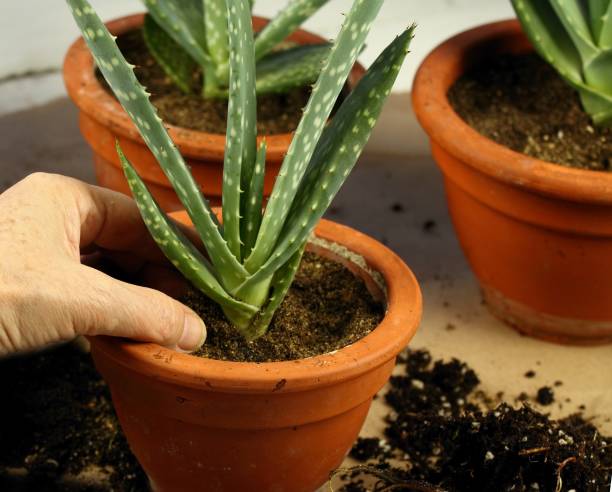Few houseplants are as beloved and renowned for their resilience as the aloe vera. Its succulent leaves have been cherished for their healing properties and decorative appeal for generations. However, if you’ve noticed your once vibrant aloe plant taking on a disconcerting shade of brown, it’s time to delve into the reasons behind this color transformation. In this CSN update, we’ll explore the various factors causing your aloe plant to turn brown and provide essential insights on how to restore its natural vibrancy.
Table of contents
Why Is My Aloe Plant Turning Brown?
Aloe plants typically turn brown due to various factors, including:
- Overwatering: Aloe vera prefers well-draining soil, and overwatering can lead to root rot, causing the leaves to turn brown and mushy.
- Poor Drainage: Inadequate drainage in the pot can result in waterlogged soil, affecting the plant’s health and causing browning.
- Inadequate Light: Aloe plants need bright, indirect sunlight. Insufficient light can stress the plant and lead to discoloration.
- Pot Size: Aloe plants may outgrow their pots. When the pot becomes too small, the plant’s roots may become crowded, affecting its health.
- Pests and Diseases: Aphids, mealybugs, or fungal issues can damage aloe plants, causing browning and other signs of distress.
- Age and Natural Cycle: Older leaves of aloe plants naturally turn brown and die as part of their growth cycle.
How To Revive A Brown Aloe Plant?
To revive a brown aloe plant, follow these steps:
- Assess the Damage: Examine the plant to determine the extent of the browning. Identify if it’s a few leaves or the entire plant.
- Trim Dead Leaves: Carefully trim the brown and withered leaves at the base using clean, sharp scissors or pruning shears. Be gentle to avoid damaging healthy parts.
- Adjust Watering: Ensure the pot has proper drainage, and water the aloe sparingly. Aloe plants prefer to dry out between waterings. Overwatering is a common cause of browning.
- Provide Adequate Light: Place the aloe plant in bright, indirect sunlight. If it was in low light before, gradually introduce it to stronger light to prevent stress.
- Repot if Necessary: If the aloe plant has outgrown its pot or the soil is depleted, consider repotting it into a slightly larger container with well-draining soil.
- Check for Pests and Diseases: Inspect the plant for pests like aphids or mealybugs. If found, treat the plant with appropriate measures, such as neem oil or insecticidal soap.
- Wait and Monitor: Reviving aloe plants takes time. Be patient and keep a close eye on its progress. New, healthy growth will eventually replace the brown leaves.
- Fertilize Sparingly: Aloe plants do not require frequent fertilization. Use a balanced, diluted, or specialized cactus/succulent fertilizer sparingly during the growing season.
Can Sunlight Exposure Affect The Color Of Aloe Plant?
Yes, sunlight exposure can significantly affect the color of an aloe plant. Aloe vera plants, like many succulents, require the right balance of light to maintain their health and color. Here’s how sunlight exposure can impact the color of an aloe plant:
- Too Much Sunlight: Excessive direct sunlight can cause aloe plants to become stressed and turn brown or reddish. Sunburn can occur, leading to discoloration of the leaves. To prevent this, provide filtered or indirect sunlight, especially in hot climates.
- Too Little Sunlight: On the other hand, insufficient sunlight can also be problematic. Aloe plants need a moderate amount of light to maintain their vibrant green color. Inadequate light can cause them to become pale and elongated as they stretch towards a light source.
- Ideal Light Conditions: Aloe plants thrive when they receive bright, indirect sunlight. Placing them near a window with sheer curtains or in a location with dappled sunlight can help maintain their healthy green color.
The key is to find the right balance of light for your aloe plant to prevent both excessive exposure and inadequate light, which can affect its color and overall health.
How To Prevent Aloe Plant From Turning Brown?
To prevent your aloe plant from turning brown, follow these care guidelines:
- Proper Watering: Aloe plants prefer to dry out between waterings. Water the plant thoroughly but allow the soil to dry before the next watering. Avoid overwatering, which can lead to root rot and browning.
- Well-Draining Soil: Ensure the pot has good drainage to prevent water from accumulating at the bottom. Use a well-draining succulent or cactus mix to provide the right soil conditions.
- Ideal Light: Place your aloe plant in bright, indirect sunlight. Adequate light helps the plant maintain its natural green color. Protect it from direct, intense sunlight, which can cause sunburn and browning.
- Appropriate Pot Size: Choose a pot that allows your aloe plant room to grow, but isn’t excessively large. This will help maintain the health of the plant and prevent overcrowding.
- Regular Maintenance: Remove dead or browning leaves promptly, as they can sap energy from the healthy parts of the plant. Use clean scissors or pruning shears for this purpose.
- Fertilize Sparingly: Aloe plants don’t need a lot of fertilizer. Use a balanced, diluted fertilizer or a specialized cactus/succulent fertilizer sparingly during the growing season (spring and summer).
- Monitor for Pests: Keep an eye out for common pests like aphids or mealybugs. If you notice any, take steps to eliminate them promptly.
Frequently Asked Questions
Aloe leaves can turn brown due to several reasons, including overwatering, poor drainage, inadequate light, age, or stress. Identifying the specific cause is essential for effective treatment.
Yes, it’s normal for older leaves to turn brown and die as part of the natural growth cycle. However, if many leaves are browning simultaneously, it may indicate a problem.
Water your aloe plant sparingly. Allow the top 1-2 inches of soil to dry out between waterings. Overwatering is a common cause of browning.
Yes, intense, direct sunlight can lead to sunburn, causing the leaves to brown. Aloe plants prefer bright, indirect sunlight.
Inspect your plant for pests like aphids or mealybugs. If found, treat the plant with neem oil or insecticidal soap to eliminate the infestation.
Repotting may be necessary if the plant has outgrown its current pot or the soil has become depleted. Ensure the new pot has good drainage.
Conclusions
Remember, a little care and attention can go a long way in preserving the beauty and benefits of this remarkable plant, allowing you to enjoy its soothing gel and decorative charm for years to come.
References
- gardenerreport.com – Aloe Plant Turning Brown? (How to Save it)
- houseplantcentral.com – Why is My Aloe Vera Turning Brown?
- myplantin.com – Why Is Aloe Plant Turning Brown & How to ID, Prevent, Fix It






